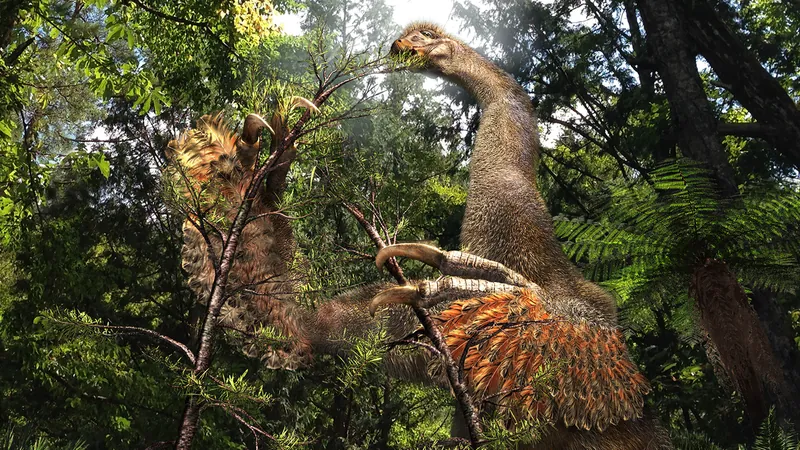
Unveiling the Mystery of Duonychus tsogtbaatari: A Giant Dinosaur with a Unique Twist!
2025-03-25
Author: Ling
Groundbreaking Discovery in Mongolia
Paleontologists have made a groundbreaking discovery in Mongolia, uncovering a new species of therizinosaur that challenges everything we thought we knew about dinosaur evolution. Named Duonychus tsogtbaatari, this fascinating plant-eating dinosaur boasts an extraordinary feature: it has only two claws instead of the traditional three seen in its relatives.
Details of the Discovery
Discovered in the Gobi Desert, this exciting find was detailed in a recent study published in the journal *iScience*. The name Duonychus translates to 'two digits' in Greek, honoring esteemed Mongolian paleontologist Khishigjav Tsogtbaatar, who has greatly contributed to the field.
"Finding a therizinosaur with only two fingers was genuinely unexpected, as the group is primarily characterized by their three-fingered, clawed hands," stated Darla Zelenitsky, co-author of the study and paleontologist at the University of Calgary. "This new species breaks the mold and provides an exciting glimpse into the evolutionary adaptations of theropods."
Therizinosaurs and Their Habits
Therizinosaurs roamed the Earth during the Late Cretaceous Period (about 100 to 66 million years ago) across what is now Asia and North America. This group, despite its inclusion in the carnivorous theropod family—which features notorious predators like Tyrannosaurus rex—was herbivorous and known for its prodigious claws, some of which could measure up to 20 inches long!
Unique Features of Duonychus tsogtbaatari
What sets Duonychus apart is not just its unique two-claw anatomy, but also the remarkably well-preserved fossil found during the construction of a water pipeline in southern Mongolia's Bayanshiree Formation. Researchers discovered a preserved keratinous sheath along the claw—something never before seen in medium- to large-sized theropods—a testament to the incredible conditions under which the specimen was buried.
According to Yoshitsugu Kobayashi, the study's lead author from Hokkaido University in Japan, "Duonychus tsogtbaatari elevates the uniqueness of therizinosaurs, showcasing a significant evolutionary divergence. The sheer detail preserved, including finger bones and a sheath that indicates the claws were both large and sharp, is astounding."
Implications of the Discovery
This newfound species is the first therizinosaur identified with fewer than three fingers, suggesting a dramatic evolutionary adaptation potentially aimed at improving its ability to grasp vegetation. Researchers theorize that the loss of a third finger may have enhanced the dinosaur’s grip, allowing it to catch leaves and branches more effectively—perhaps akin to how modern chameleons maneuver their limbs.
Kobayashi further proposed that the unusual claws might have served additional purposes, such as for defense, mating displays, or play, showcasing the multifaceted role these adaptations may have played in the dinosaur's lifestyle.
Conclusion
The discovery of Duonychus tsogtbaatari marks another exciting chapter in our understanding of dinosaur evolution, indicating not merely a fluke but a true evolutionary shift. As more fossils surface, scientists are eager to see how this finding will recalibrate our comprehension of therizinosaurs and theropod evolution at large.
Stay tuned, because as fossil hunters continue their quest, we are sure to witness more astonishing revelations that will reshape our perception of these ancient giants and their incredible adaptations!



 Brasil (PT)
Brasil (PT)
 Canada (EN)
Canada (EN)
 Chile (ES)
Chile (ES)
 Česko (CS)
Česko (CS)
 대한민국 (KO)
대한민국 (KO)
 España (ES)
España (ES)
 France (FR)
France (FR)
 Hong Kong (EN)
Hong Kong (EN)
 Italia (IT)
Italia (IT)
 日本 (JA)
日本 (JA)
 Magyarország (HU)
Magyarország (HU)
 Norge (NO)
Norge (NO)
 Polska (PL)
Polska (PL)
 Schweiz (DE)
Schweiz (DE)
 Singapore (EN)
Singapore (EN)
 Sverige (SV)
Sverige (SV)
 Suomi (FI)
Suomi (FI)
 Türkiye (TR)
Türkiye (TR)
 الإمارات العربية المتحدة (AR)
الإمارات العربية المتحدة (AR)